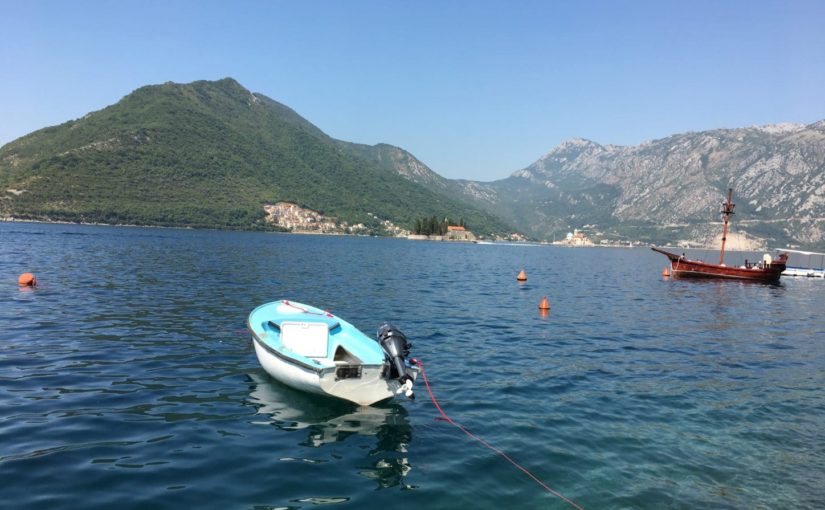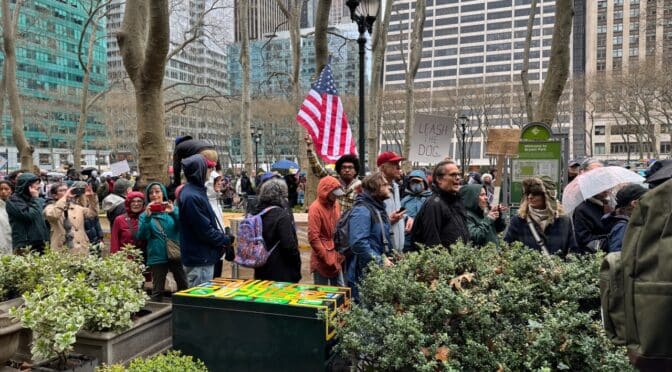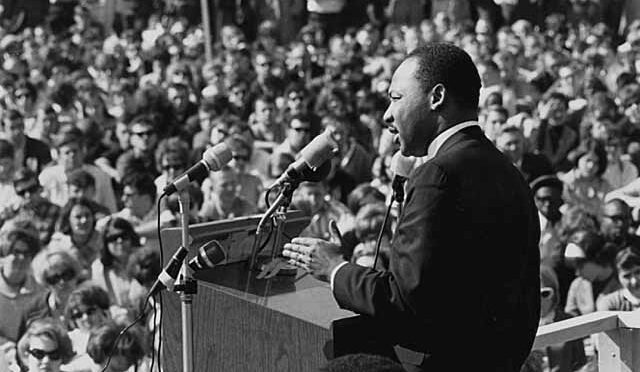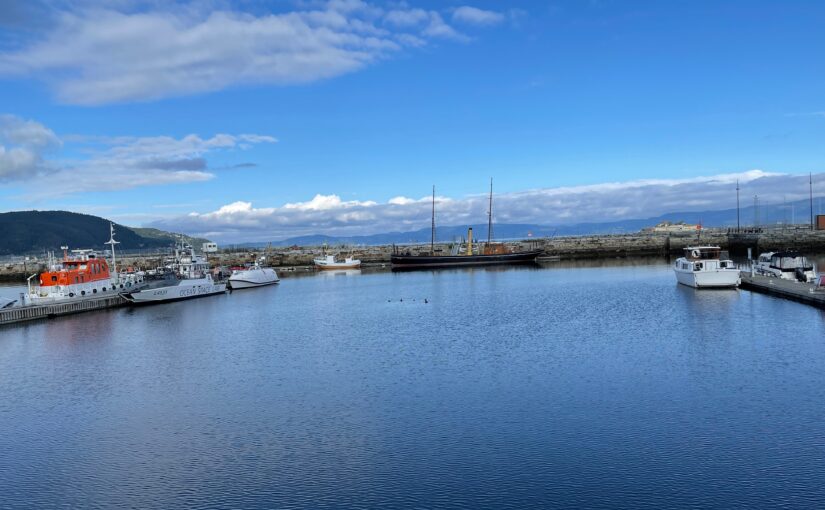updated July 19, 2018
Kravice Falls, Montenegro, Perast and the Beautiful Bay of Kotor
A Trip To The Balkans Part 4
by Nick Taylor and Barbara Nevins Taylor
With Montenegro in the news thanks to President Trump’s questioning its membership in NATO, we want to share what we found on our trip to the small and scenic Balkan country.
We began in Mostar, Bosnia, and detoured southwest to see the waterfalls at Kravice, which locals described as spectacular. Lonely Planet’s Eastern Europe guide calls them a “splendid . . . mini-Niagara.”
The road took us up and across a stark plateau, then descended through a series of small towns until we saw the signs to Kravice with a falling water logo. Soon we entered a dusty parking lot with a smattering of trees. One was free and we parked beneath its shade. The heat wave was still blistering the Balkans, with high 90s F.
At the window to pay the parking fee we searched our pockets and realized we used up our supply of Bosnian money. Others had the same problem, and a man in front of us paid five euros.
We didn’t have any euros, but I thumbed through my wallet and pulled out a five dollar bill and handed it to the attendant, shrugging to say I didn’t have what he wanted. He took it, held it up, looked at it front and back, and nodded with an expression that said, “I don’t know why I’m doing this.”
We joined a steady stream of visitors, many families carrying towels and beach chairs, on the path down to the waterfalls. Here and there stone steps broke the path, which switched back on itself because the grade was steep. The sound of water falling on water rose from below.
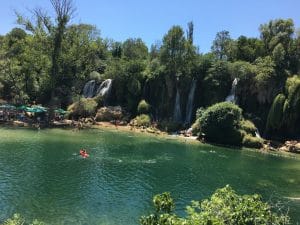
At a final set of steps the falls came into view. As many as ten cascades sixty to eighty feet high plunged down green cliffsides into a swimming hole. Swimmers batted a beach ball around out in its center, while bathers sprawled in the sun around its sandy edges. It was a lovely setting, but to call these falls a “mini-Niagara” was pure exaggeration.
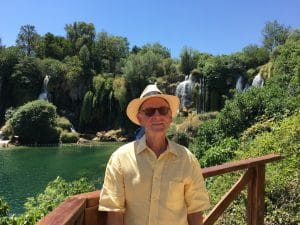
Barbara and I took a few pictures and climbed back to the parking lot. But first we made a stop. And again, the cleanliness of public restrooms surprised and delighted us. Cleanliness seems like a byword for the Balkans. Every hotel small or large was clean. Every public restroom along the way was extremely clean. Barbara had a fussy mom, and passed the cleanliness bug along to her, especially about public restrooms. So this became very important.
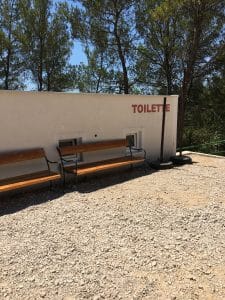
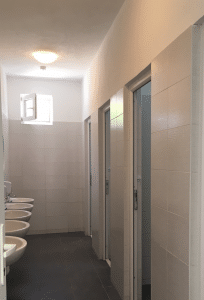
On the road again, we set our sights for Montenegro and the Bay of Kotor.
This meant we had to make a choice. We’d learned that crossing borders in the Balkans can consumer a lot of time.
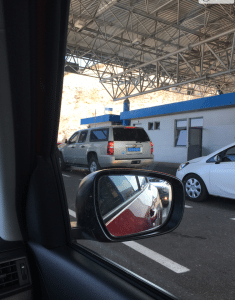
So should we head for the busier crossing near Trebinje and the coast, or the more remote one in the mountains near Bileca? We chose Bileca.
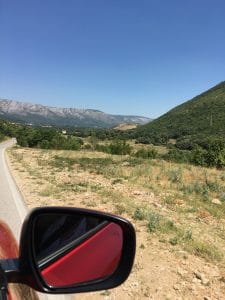
Once more the road led through spectacular stark mountains and towns that showed up only as dots on our Hertz map of the western Balkans.
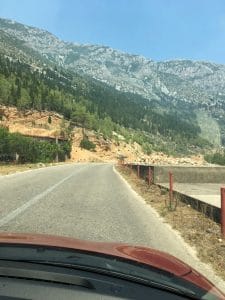
At Bileca we thought about lunch and remembered we were Bosnian cash poor. We got fifty convertible marks at a cash machine, bought a couple of sandwiches and spent the rest filling up with gas. Then we headed for the border.
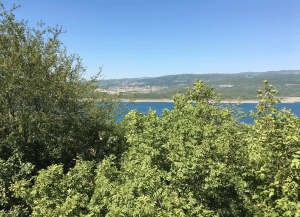
Bileca lies at the north end of Bileca Lake, created when the Tresbisnjica River was dammed for hydroelectricity in 1968. Some of the lake overlaps into Montenegro.
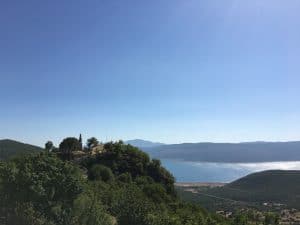
The road to the border took us along its north shore. Soon we rose to the mountain pass and the crossing at Vracenovici.
The smattering of trucks and cars told us we had made the right choice.
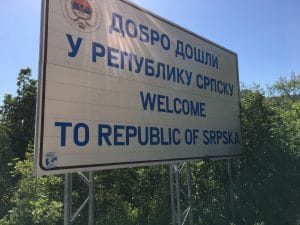 The Republika Srpska border guard gave us a perfunctory wave through. On the Montenegro side, Barbara took our passports and car papers into the checkpoint office, chatted with border guards Dragon and Vladon, watched them scan the passports and returned in five minutes giving a smile and a thumbs-up.
The Republika Srpska border guard gave us a perfunctory wave through. On the Montenegro side, Barbara took our passports and car papers into the checkpoint office, chatted with border guards Dragon and Vladon, watched them scan the passports and returned in five minutes giving a smile and a thumbs-up.
Signs to Kotor didn’t exist and we made a wrong turn that took us onto a narrow dirt road where we met a local family in a dusty Mercedes. I asked the driver if it was the road to Kotor. He shook his head, clamped his left hand on his right arm and pointed back the way we’d come. I gathered that meant a right turn somewhere, and one more stop to ask directions confirmed it.
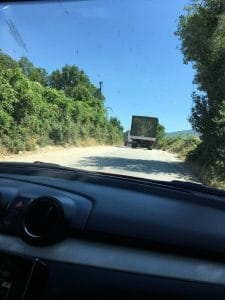
We followed a narrow road with crumbling edges but trucks going the same way indicated it was a road to somewhere. Then it improved and opened up vistas, yet again, of the impossibly rugged mountains we’d seen throughout our trip.
We emerged from the mountains above the Bay of Kotor. My sailing friend Spencer Smith, who keeps his boat on the Croatian coast, said it was beautiful and boy was he was right.
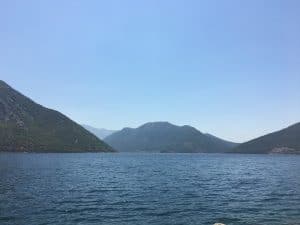
The green mountains plunged steeply and held the sprawling bay, shaped like a rough anchor, in a sheltering embrace. Beyond its far side, though more mountains blocked the view, you sensed the empty horizon over the Adriatic Sea.
The road descended and switched back to follow the shoreline. We passed Strp and Risan.
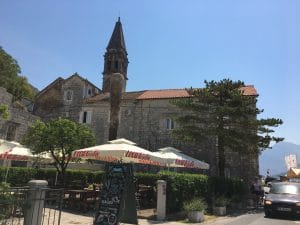
Hotels clustered on the high side of the road. Traffic slowed near Perast, our destination, with buses and day trippers’ cars directed toward a parking area. I said we were going to the Hotel Conte, and got waved through to a narrow road along the water.
We’d found the Conte Hotel on Booking.com and it proved a good and interesting choice. The hotel reception office faces the bay and many of the rooms lay tucked away in the warren of centuries-old stone houses on the hillside.
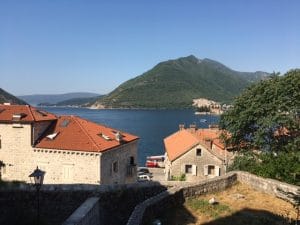
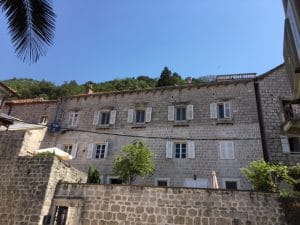
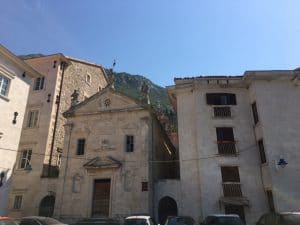
“We have rooms all over the place,” said the receptionist when we checked in. A valet disappeared to stash our car somewhere and we paused to take in the view.
We sat at one of the hotel’s waterside tables
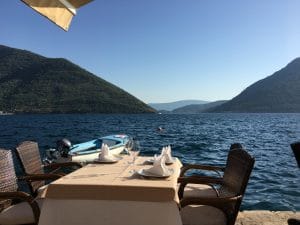
and enjoyed glasses of complimentary prosecco. We felt a rush of overwhelming pleasure at the peace and the calm of this beautiful place.
Although we really didn’t want to leave the water’s edge, we knew we should find our room.
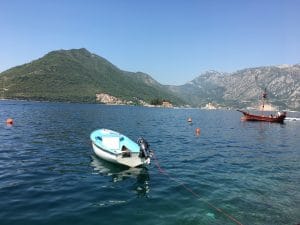
Two big young men, hotel employees, pulled our bags and led us past a church, a basketball court and ice cream shop.
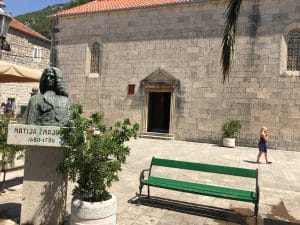
We should say that we consistently met tall, big men in the Balkans. In fact the data collected by people who chart this stuff indicates Montenegrins, Croatians, Serbians and Bosnians, all people who live in the Dinaric Alps region, run among the tallest in the world. They average over six feet one.
Montenegro also ranks as one of those countries others have fought over for centuries. It only became a nation on its own in 2006.
It was part of the Byzantine Empire in the 10th century and then became aligned with Serbia in the 12th and 13th centuries.
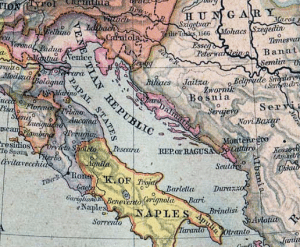
By the 15th century Venice and Hungary vied for power here with Venice gaining the upper hand until the French had a brief reign in the early 19th century. Then Austria captured the area and ruled until 1918, when Perast and Montenegro became part of Yugoslavia. During World War II, Mussolini annexed it and put the area under the Governorship of Dalmatia until it was returned to Yugoslavia in 1945.
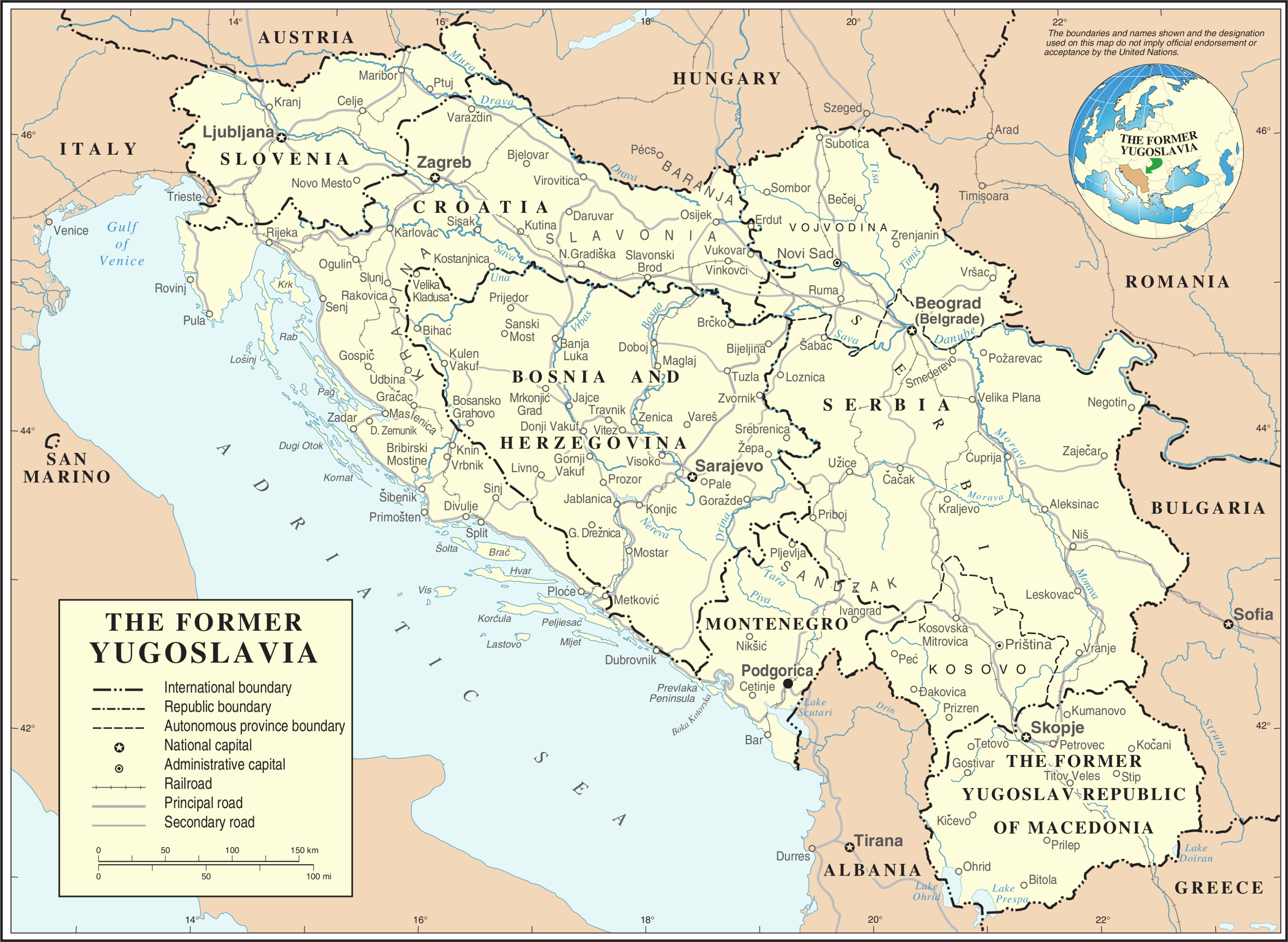
More recently, Montenegro, a little smaller than Connecticut, was very much involved in the brutality of the 1990s’ Balkan war. As Croatia moved to pull out of Yugoslavia in 1991, Montenegro aligned with Serbia and its army attacked and bombed Dubrovnik.
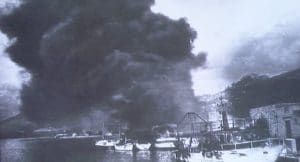
The Serb-Montenegro alliance was partly based on religion; the Montenegrins, like the Serbs, practice Eastern Orthodox Christianity. Twelve percent of the people in Croatia were Serbian at the start of the war and they didn’t want to give up their land to the Catholic Croatians, just as they didn’t want to give up their territory in Bosnia-Herzegovina to Muslims.
Back in the present, Barbara asked Nick, the hotel staffer who pulled her bag, whether he was Catholic or Christian Orthodox. She felt him bristle and grow an inch beside her. “Christian Orthodox. We are Christian Orthodox here in Montenegro,” he said. Actually, 74 percent of the country is Orthodox, 3.5 percent Catholic and 18 percent Muslim, according to the U.S. State Department.
We turned beside a building where the walk led to a long set of stone steps.
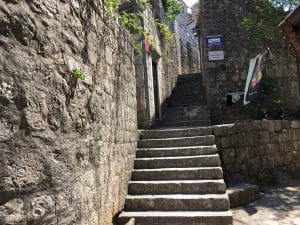
Nick and his colleague hoisted our (heavy) bags and started climbing. This Nick was glad to have the chore taken off my hands.
We reached a small landing near the top, and Nick’s partner put down the bag he carried and disappeared.
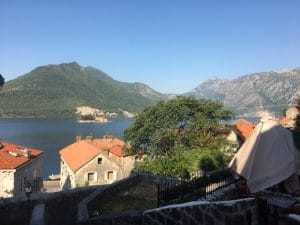
Nick opened the door to our room and revealed much more than a room, much more than what we anticipated when we booked.
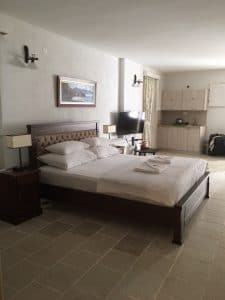
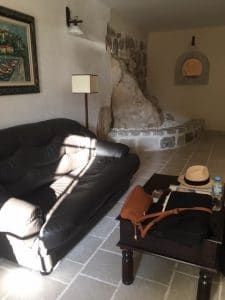
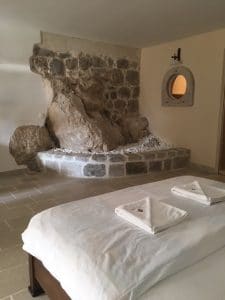
It was a lavish studio suite that extended past a sofa and a king-sized bed to a bathroom that featured, in addition to the usual fixtures,
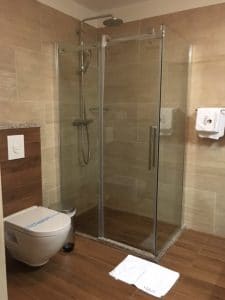
a jetted spa that looked as if four people (or two large Balkan men) could fit in.
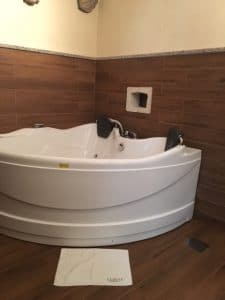
We rolled our eyes. Who, with eye candy like the Bay of Kotor right outside, would spend time lolling in a hot tub? Well, maybe in winter. As for views of the bay, a terrace with chairs and an umbrellaed table right across from our room was ours to use.
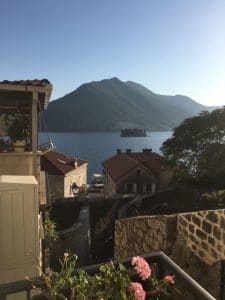
At some point we realized the small windows of our room’s one windowed wall opened on the terrace of a local family, and we could see as well as hear them mere feet away. Closing the frosted windows solved that problem.
We went down to dinner about nine. The evening softened around us as we sat inches from the water at the hotel’s outdoor restaurant and watched lights blink on around the bay.
After the lamb and meat of Bosnia, we craved fish. The menu had what we were after. Barbara ordered fish soup and I had gazpacho to start. She let the waiter talk her into poached sea bass and wished she’d had it grilled, while my plate with black risotto (with cuttlefish), skewered shrimp and grilled octopus and squid gave me the tastes I craved.
The wine list featured selections from around the Balkans as well as Italy, Spain and France, but when in Rome . . . A couple at the next table, Amy and Brian, encouraged us to drink Montenegrin.
The Montenegrin sauvignon blanc was delicious, and a bargain. Our dinner mates both worked for the government on Guernsey, an island in the English Channel off the coast of Normandy, that with two other islands form the Bailiwick of Guernsey. Guernsey has what they term “a crown dependency.
That means it governs itself but depends on the UK to defend it, provide the diplomatic links to the outside world, and assist with trade. Brian travels back and forth as a liaison between the government and the British parliament. Amy works with Guernsey’s legislators to help put their ideas into practice. She clearly understands how to plan.
She was interested in Montenegro and organized their drive along the coast from south to north. Perast was their last stop. They talked about the beauty of the drive, and the places they stopped.
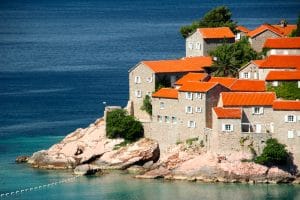
The conversation turned to the complications Brexit will cause for Guernsey and then they wanted to know, guess what? “How could Americans elect Donald Trump?” Amy asked. Brian shook his head. We launched into our explanation about angry working-class Americans anxious about the future of jobs and opportunities for them, and Trump’s brilliant manipulation of fear, the Russian election tampering, James Comey, and Hilary Clinton’s weaknesses as a candidate.
Like others we met, they listened with great interest. But they still could not believe people from the country they have admired from afar could pick a man like Donald Trump.
We lingered after they left and enjoyed the scent of the sea and soft breeze of the night and did not talk about politics.
The next morning, we again took a table under the awnings at the water’s edge.
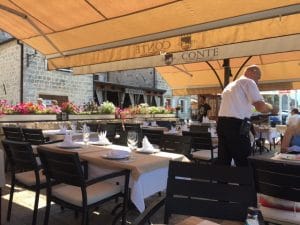
As we watched teeny fish swim after crumbs a child dropped in the water,
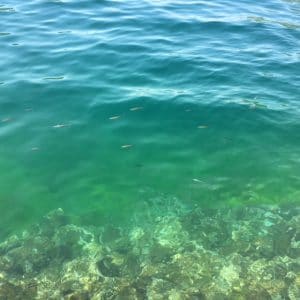
we wondered if we should stay another day. The beauty and calm of Perast enchanted us.
The buzzing of a drone coming over the water attracted our attention. It hovered and darted around, its camera apparently interested in what was on our breakfast plates. It flew away as soon as we tried to take a picture of it. A minute later, a smaller drone replaced it.
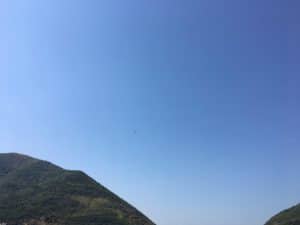
That got us talking to an extended family at the table behind us. A couple from Atlanta, where we had lived in the 1970s and early ’80s, was there with their two sons and their families.
These Georgians were vacationing in Montenegro because one of the sons, Drew Giblin, is the Cultural Affairs Officer at the U.S. Embassy in Sarajevo and his wife also works for the State Department there. We explained that we’d just come from Sarajevo and Barbara asked, “How do you deal with what seems like an overwhelming challenge?” Drew smiled and said diplomatically, “We appreciate every small victory.”
We resisted the temptation to stay another day, but did take in the beautiful Church of St. Nicholas with a bell tower that you could climb.
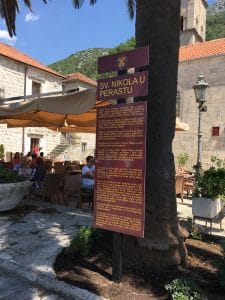
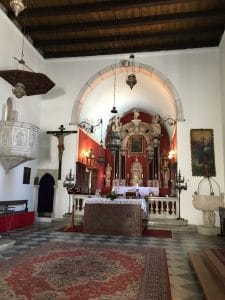
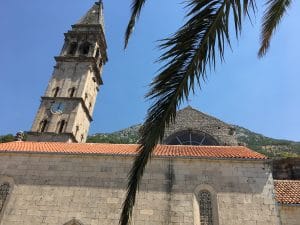
Now we faced another route decision. Google Maps told us we’d get to Dubrovnik faster by the coastal road, but not by much. We could also return to the border crossing near Bilaca, tempting because of the light traffic. But that would mean two crossings, into Bosnia and then into Croatia. We chose the coastal route.
The road took us along the bay for thirty kilometers or so.
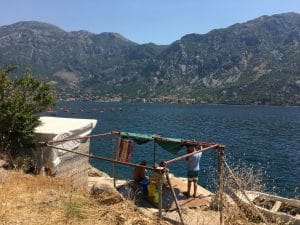
Near Herceg Novi it turned inland toward the Croatian border. Not long afterward the traffic slowed and stopped and we joined a long line of cars fitfully moving toward the checkpoints up ahead.
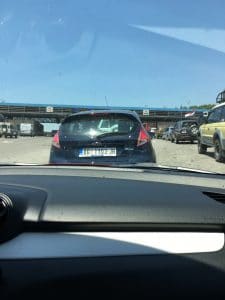
Twenty minutes later, though, we were through and driving toward Dubrovnik, its old city sheltered by stone defensive walls dating to before the Middle Ages. “Game of Thrones” location scouts saw Kings Landing in Dubrovnik and set other scenes from the popular HBO saga throughout the ancient city. We were eager to see it for ourselves.
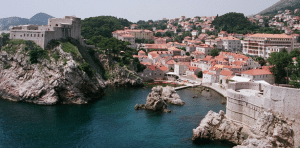
![]() Read the previous post here.
Read the previous post here.
Take a look at Kravice Waterfalls
